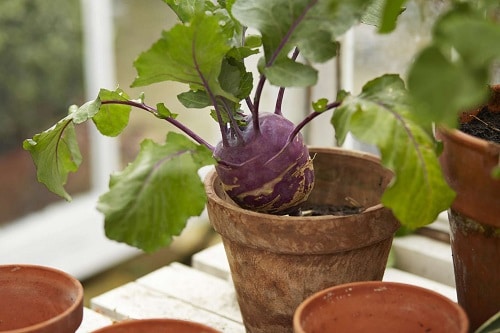Not many gardeners try Growing Kohlrabi in Pots as they consider it tricky. But after reading this post, you’ll come to know how easy it is!
Kohlrabi is a cool-weather crop and part of the cabbage family. It has a tender bulb-like stem that possesses a mild and sweet flavor with a hint of a turnip. The bulb-like stem is the edible part of kohlrabi that grows above the ground and foliage. If you love this vegetable, have a look at Growing Kohlrabi in Pots to enjoy it in your salad, stir-fries, or sautés!
Botanical Name: Brassica oleracea
USDA Zones: 4-10
Common Names: Kohlrabi, Turnip-rooted cabbage, Stem turnip, Turnip cabbage, Knol-kohl, Kohl rabi
Look at the Vegetables You Should Never Plant Together and Why
How to Grow Kohlrabi in Pots?

Propagation
Sow several seeds, half inches deep, directly in the container. Once the seeds germinate, thin out the seedlings, leaving only one healthy plant per pot. Transplant the thinned-out seedlings in the garden. Another option is buying baby kohlrabi plants from a nursery and transplanting them into pots.
Planting Time
Spring and fall are the two best seasons for planting kohlrabi. For spring planting, you can start sowing seeds four weeks before the last expected frost, which gives the plant a chance to grow in cold weather.
You can also plant kohlrabi seeds outside when temperatures exceed 7 C (45 F).
Whereas for growing kohlrabi in fall, plant it at least around 6 weeks before the first frost. In cool weather, the flavor of kohlrabi improves by turning somewhat sweet.
Note: If you live in a frost-free climate (USDA Zone 10, 11), the best kohlrabi planting time is in fall and winter.
Requirements for Growing Kohlrabi in Pots

The best pot size for growing kohlrabi is around 12 to 14 inches deep and wide.
Location
Place this vegetable at a location where it can receive at least 6 hours of sunlight each day. For healthy and fast-growing plants, sunlight is crucial. However, Kohlrabi can tolerate partial shade to some extent. You can also grow it on your balcony or on your patio.
Soil
According to the University of Minnesota, loamy, well-draining soil that is rich in organic matter with a pH of 6.0 to 7.5 is ideal. You can further amend the soil by adding well-rotted manure or compost once or twice during the growing period.
Watering
To prevent the stem from turning tough and woody, keep the soil evenly moist. In containers watering frequently becomes even more important as they dry out quickly. In any case, avoid overwatering.
Learn Growing Beets in Containers
Kohlrabi Plant Care

Fertilization
Feed the plant with a balanced liquid fertilizer. The best time to fertilize the plant for the first time is when they are 3-4 inches in height or when the first set of true leaves appear or about a month after sowing seed–whichever happens first.
If you are adding compost or aged manure, you don’t need to use inorganic fertilizers. If not, apply weak-strength liquid fertilizer every 2-3 weeks.
You can also add blood meal, cottonseed meal, or composted manure to the soil before planting for enrichment.
Pests and Diseases
Cutworms, cabbage loopers, aphids, and imported cabbage worms can cause damage. However, when growing it in pots, you don’t have to worry much about them. To keep the pest infestation in check, wash the plant with a diluted soap solution and get rid of egg clusters present under the leaves.
Spraying with Bacillus thuringiensis is a sure-shot way to eliminate cabbage worms. To prevent diseases such as cabbage yellows, clubroot, and downy mildew, go for disease-resistant varieties.
Check out Best Cruciferous Vegetables You Can Grow
Harvesting and Storage
For each family member, grow at least 3-4 kohlrabi plants.
The bulbs are ready for harvest when they grow to 2-3 inches in diameter. Don’t wait too long, as young and tender bulbs are more flavorful and crisp. Cut the stem from the plant’s base with the help of a knife. You can store kohlrabi for 2-4 weeks by keeping them in a perforated plastic bag in a refrigerator.
The leaves are also edible, and you can steam or sauté them, just like kale. They can also be used to make chips.


